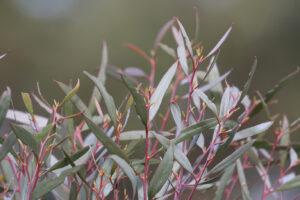
The chemistry of eucalypts
By Daniel Fuller
As part of my podcast series celebrating National Eucalypt Day, I had the good fortune to interview Professor Ros Gleadow who is a professor at Monash University, President for the Global Plant Society, and a board member of Eucalypt Australia, about the chemistry of eucalypts and it was an enlightening experience.
The chemical profile differs a lot between different eucalypt species, and even between leaves on a single tree.
Each leaf contains many glands, which you can see when you hold a leaf up to the light. Each individual gland will have individual compounds. Two leaves from the same tree will have a different chemical profile, but if you examine the whole tree, its overall chemical profile will be typical of its species.
Some Corymbia spp. contain chemicals that are the same as that found in geraniums (geraniol), and citrus (limonene). The blue mallee (Eucalyptus polybractea) and the blue gum (Eucalyptus globulus) contain cineole, which is the characteristic smell of pharmaceutical grade eucalyptus oil.
There are several reasons hypothesised for why members of the Myrtaceae family, such as eucalypts, produce oils. Some have wondered if the oils make the leaves slightly translucent, allowing light to reach the lower leaves. Another possibility is that the increased flammability encourages the leaves to burn quickly so the whole plant doesn’t die. The chemicals also deter certain herbivores, so there are probably several ways that they benefit the plants.
Some animals are able to consume gum leaves, from which they receive carbohydrates, protein, water and micro nutrients. The leaves also have some nasties like natural toxins, lignins and phenolics which prevent most organisms being able to rely on them as a stable food source.
Animals like koalas aren’t able to digest them on their own and need bacteria in their gut to digest it, similar to how ruminant animals like cows need a type of bacteria to break down pasture.
Contrary to popular belief, eucalyptus leaves are not psychoactive, and koalas are not “stoned”. They simply have a low metabolic rate to conserve energy due to the poor nutrition of the leaves.
Humans can’t digest eucalypt leaves, although we are able to make tea from certain species. Be careful, however, as there are a number of species such as sugar gums (Eucalyptus cladocalyx) that contain cyanogenic glucosides which are highly toxic to mammals.
Eucalyptus oils are used by humans for their aroma, their antimicrobial properties and as a powerful natural solvent. Ros was part of research studying the efficiency of eucalypts to combat malaria and found that there was evidence for this use as well.
There truly is no way to explain how the smell of eucalypts colours the Australian experience. Even if you don’t get out to the bush, you’re never too far away from a eucalypt and I highly encourage you to crush up a leaf and have a sniff next time you step outside.
Daniel Fuller
Plants Grow Here
M: 042 6169 708
E: hello@plantsgrowhere.com
